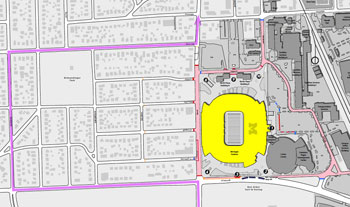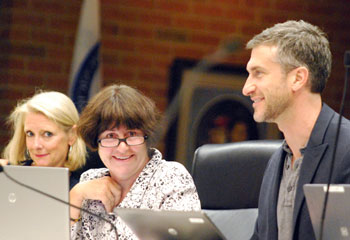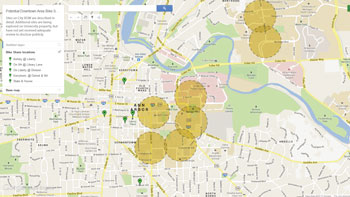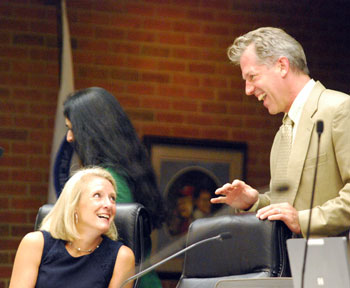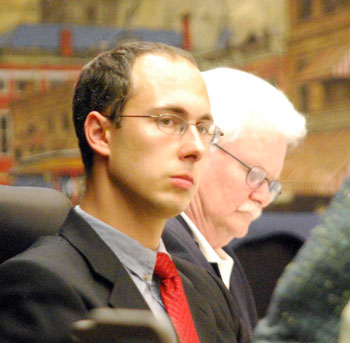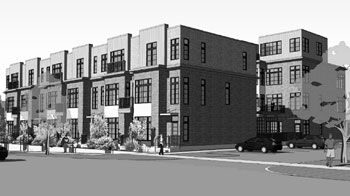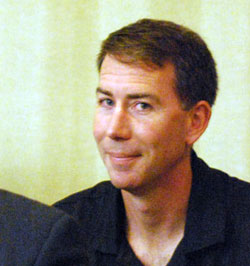Street-Closing Debate Extends Council Session
Ann Arbor city council meeting (Aug. 8, 2013): Counting all public hearings and public commentary, members of the public accounted for just 20 minutes of the council’s meeting. Still, councilmembers stretched a relatively light agenda to about four hours.

Marcia Higgins (Ward 4) and Stephen Kunselman (Ward 3) share a light moment before the Aug. 8 meeting started. They had both contested Democratic primaries two days earlier. Kunselman prevailed in a narrow race against Julie Grand. Jack Eaton won the Ward 4 race. (Photos by the writer.)
An hour of the meeting was taken up with a discussion of street closures around Michigan Stadium on football game days. The street closures are part of an effort to increase safety by creating a vehicle-free zone around the stadium. It involves a cooperative effort with the University of Michigan, U.S. Department of Homeland Security and the city of Ann Arbor police department.
Those deliberations ultimately resulted in a modification of the original plan, so that the southbound lane of Main Street would not be closed until an hour before the start of the game.
Other parts of the plan were approved as originally proposed, starting three hours before kickoff: E. Keech Street between S. Main and Greene streets will be closed, and access to Greene Street from E. Hoover to E. Keech streets will be limited to parking permit holders; the westbound lane on E. Stadium Blvd. turning right onto S. Main Street (just south of the Michigan Stadium) will be closed; and S. Main Street except for the southbound lanes will be closed from Stadium Boulevard to Pauline.
The council also amended the plan to require a report by its Oct. 7 meeting on how well the procedures are working. Even with the modification to the plan and the requirement to brief the council on Oct. 7, the proposal to close streets on football Saturdays was approved on just a 7-4 vote, with dissent from Sabra Briere (Ward 1), Sumi Kailasapathy (Ward 1), Margie Teall (Ward 4) and Marcia Higgins (Ward 4). That neighborhood is located in Ward 4.
Also during the meeting, the council denied a requested street closure for a non-university event on South University Avenue. The requested closing was for “Beats, Eats, and Cleats,” sponsored by The Landmark apartment building. It was planned for the evening before a football game between the University of Michigan and the University of Notre Dame. Councilmembers expressed concerns about the probability of alcohol consumption.
Another 40 minutes of the meeting was taken up with discussion of a bike share program, which did have a direct connection to the University of Michigan. The council was asked to contribute $150,000 from the city’s alternative transportation fund. That money provided a 20% local match on a $600,000 Federal Highway Administration Congestion Mitigation Air Quality (CMAQ) grant that the Clean Energy Coalition (CEC) has received. The CMAQ funds have to be spent on capital, such as bikes and stations. Operations will be supported in the first three years of the program by UM at a level of $200,000 annually for a total of $600,000. The program will be operated by the CEC using B-Cycle as a vendor. The council’s vote on the bike share program was 9-2, with dissent from Sally Petersen (Ward 2) and Marcia Higgins (Ward 4).
Higgins also dissented on a council resolution that called upon the state legislature to repeal Michigan’s version of a “stand your ground” law, as well as to repeal legislation that prevents local municipalities from regulating the sale, transfer, transportation, or possession of firearms and ammunition. That resolution came after public commentary on the verdict in the Trayvon Martin case at the council’s previous meeting. Higgins agreed with the sentiments in the resolution, but said she thought it would have a greater impact if people spoke as individuals. Other councilmembers expressed some skepticism that the resolution would have much impact, but it received their support.
The Kerrytown Place project – an 18-unit townhouse development planned for the location of the former Orthodox Greek church on North Main Street – was subjected to only brief remarks. The council unanimously approved its requested rezoning and site plans.
In other business, the council approved a $10,000 design budget for a sidewalk on Waldenwood near King Elementary School. Construction of the sidewalk would allow a mid-block crosswalk to be moved to a four-way stop intersection.
The council also agreed to accept $202,370 from the Federal Farm and Ranch Land Protection Program (FRPP) to help the city purchase development rights on land in Lodi Township, southwest of the city.
Over dissent from Jane Lumm (Ward 2) and Sumi Kailasapathy (Ward 1), the council approved $18,500 to pay for public art administrator Aaron Seagraves’ contract through the end of 2013.
Among the nominations to boards and commissions announced at the meeting, two were significant: Rishi Narayan, founder and managing member of Underground Printing, to the board of the Ann Arbor Downtown Development Authority; and Jack Bernard, chair of the University of Michigan’s council for disability concerns, to the board of the Ann Arbor Area Transportation Authority.
Street Closures
The council was asked to approve street closures for all University of Michigan home football games. The council was also asked to approve a street closure for a one-off, non-university sponsored event – but timed for the evening before a home football game.
Street Closures: 2013 UM Football Games
This is the first year that the council has been asked to approve street closings around Michigan Stadium on all football game days. According to the staff memo accompanying the resolution, it’s part of an effort to increase safety by creating a vehicle-free zone around the stadium, and involves a cooperative effort with the University of Michigan, U.S. Department of Homeland Security and the city of Ann Arbor police department.
Street Closures: UM Football Games – Council Deliberations
On hand to answer questions were AAPD police chief John Seto, UM Dept. of Public Safety deputy chief Melissa Overton, and an official from U.S. Homeland Security.
Seto led off by providing background on the issue. He described the street closures as a request that came from the University of Michigan public safety department, working in conjunction with U.S. Homeland Security. Seto described how he had asked for some modifications before he was comfortable with the request. He described a community meeting on July 24, saying that many comments and suggestions had been received. One modification Seto described coming out of that meeting was that southbound lanes of Main Street would be open until one hour before the game start.
Marcia Higgins (Ward 4) said she hadn’t seen the modified proposal, pointing out that the resolution on the agenda did not include the modifications. Higgins noted that she attended the community meeting. On football Saturdays, she said, the city does a great job for people going south, but not west.
Higgins made clear that she would not support the street closing, saying that the security issue was brought up at the time that the university renovated the stadium. The university had decided to build out as close to the street as possible, Higgins said. She wasn’t opposed to closing the right-turn lane on Stadium Boulevard, she said, but for the rest of the closures, she’d respect her constituents. As an argument against the proposal, she noted that the exact game start times aren’t necessarily known months in advance. She thanked Seto for attending the neighborhood meeting. But she contended that there should have been a meeting held earlier than two weeks before the council needed to vote.
Sabra Briere (Ward 1) had questions for UM representatives. Briere noted that Ann Arbor is not unique as a city in hosting football games. Do other cities close streets near their stadiums? Ohio State University and University of Wisconsin close streets, Overton explained. Seto then gave more detail on game-day operations in other cities. Briere confirmed with Seto that the street closures in other cities are due to security concerns.
Sumi Kailasapathy (Ward 1) asked how closing the street helps to prevent terrorism. Seto explained it’s part of what can be done as a “reasonable” approach. A Homeland Security official was invited to the podium, and he described how blast modeling of a small truck laden with explosives showed that considerable damage could be done. The recommended street closures were based on that blast modeling, he explained. Kailasapathy ventured that the same truck could come at the end of the game. Why is there a higher threat before the game? she asked. Overton explained that just before the game is when the heaviest pedestrian traffic occurs and when the most people are inside the stadium.
Seto added that the idea is to open things up in order to dissipate the crowd as quickly as possible. For some games, he noted, the crowd starts to leave early.
Responding to the 2010 date given for the Homeland Security recommendations, Sally Petersen (Ward 2) wondered why it’s taken three years to implement those recommendations. Higgins pointed out that East Stadium bridges were closed at the time for reconstruction. Jane Lumm (Ward 2) indicated that for her it was significant that few complaints were received – based on Seto’s report – when street closures were implemented for a nighttime Notre Dame game in 2011.
Christopher Taylor (Ward 3) ventured that the main threat that is supposed to be mitigated is a potential truck bomb. Seto indicated that it’s one part of the motivation. Taylor inquired about the possible one-hour/three-hour mix of lane closures. Seto explained the balance between asset protection and the interest in getting the crowd to dissipate. The representative from Homeland Security explained that the proposed street closure plan around Michigan Stadium meets the national standards for security for major sporting events.
Mike Anglin (Ward 5) asked who would pay for the extra security measures. Overton explained that the UM athletic department would pay the costs. Anglin asked how much the city contributes to the provision of security for football games.
Higgins responded to Anglin’s question by explaining that signs and signals work required in connection with football games is now paid for by the university. Higgins then asked who owns the barricades. Overton explained that the university owns the portable vehicle barriers (PVBs), which were purchased with Homeland Security funds, and described how they could be moved by two people.
Seto recalled how difficult it was to determine the end of the 2011 Notre Dame game, which included overtime periods, he contended. That description was corrected later in the meeting, when Petersen reported that she’d received a communication from a family member during the meeting saying that there were not any overtime periods but that the game had been decided on a play late in the fourth quarter.
Higgins challenged Seto’s characterization of the 2011 UM-Notre Dame game day logistics, saying that there were many issues associated with the 2011 street closures that perhaps Seto wasn’t aware of. She stressed that after the first three games this year, the residents want a review of how well things are working. Seto assured Higgins that review would be done.
Higgins asked what will happen if it turns out that the logistics aren’t working out. She ventured that the resolution should be modified to reflect that possibility.
Briere asked public services area administrator Craig Hupy to come to the podium. She asked about increased traffic flow in neighborhood streets, citing the possibility of increased deterioration of streets due to added traffic. Hupy indicated that would be minimal compared to the amount of traffic volume over the entire life of the street. Hupy explained that the concern is actually about diminished traffic, which could have a negative impact on the lawn parking that residents enjoy.
Lumm then moved to amend the resolution to make the closure of the southbound lane on South Main restricted to just one hour before the game start.
Outcome on Lumm’s amendment: The amendment passed unanimously.
Chuck Warpehoski (Ward 5) explained that he was living in Washington D.C. on 9/11. Many people had mourned the increased “locked down” status of the city following that attack, and he’d shared that view. Now, however, he weighs the question of “What if I’m wrong?”
Stephen Kunselman (Ward 3) followed up on the issue of reimbursement by UM for the signs and signals work. Hupy reported that when the city has billed the UM recently, the invoices have been paid. Kunselman then said as everyone knows, he works at the university. [Kunselman is a Planet Blue energy conservation liaison.] He called the street closures a public safety issue. He recalled being able to sneak in through a hole in the fence as a youngster. But it’s a changing world and we have to accommodate the change, Kunselman said. So he’d support the resolution.
Briere wanted to make sure the street closing procedures were reviewed soon enough for the council to take action to revise them at the Oct. 7 council meeting. Higgins followed up by saying she wanted to add a resolved clause stipulating that following the first three football games, the AAPD would meet with the neighborhood and bring recommendations to the Oct. 7 city council meeting. Briere said she’d support such a resolved clause.
Lumm asked Seto to come back to the podium. Seto said what’s being asked in terms of reporting is doable. He could hear concerns and make suggestions, he continued, but there would probably be certain things he couldn’t fix.
Mayor John Hieftje asked Seto how easily things could be changed in the middle of the season. Seto expressed confidence that AAPD could be flexible. He gave the Ann Arbor marathon as an example of that. He described how AAPD often modifies its logistical operations on the fly. Hieftje expressed some concern that the plan called for taking down the barriers too soon – at the conclusion of the game. Seto described the balance that is to be struck on that issue.
Outcome: The amendment to include a report to the council by its Oct. 7 meeting was unanimously approved.
Margie Teall (Ward 4) said she still could not support the resolution, based on what she’d heard from the neighbors. She’d heard a lot of complaints about the 2011 Notre Dame game.
Petersen countered by calling the street closures “common sense,” saying it’s a public safety issue. She pointed out that the council had heard many voices calling on the council to ensure that public safety meets national standards – and she cited the Homeland Security official’s point that this street closure plan met national standards for football games in large stadiums. She could think of 114,000 good reasons to support this resolution [the population of the city], plus another 107,000 reasons [the capacity of the stadium], though she allowed there could be some overlap in those two figures.
Lumm said she appreciated the modification of the closure of southbound Main to be just one hour before the game started. Higgins responded to comments by Lumm and Petersen about meeting national standards for security, by saying UM needed to think about meeting those standards as it builds out its campus. Higgins somewhat wistfully said that in the future that will be the rest of the council’s problem – an apparent reference to her loss in Tuesday’s primary election.
Outcome: The council voted to approve the street closures around the Michigan football stadium on game days. Dissent came from Sabra Briere (Ward 1), Sumi Kailasapathy (Ward 1). Margie Teall (Ward 4) and Marcia Higgins (Ward 4).
Street Closures: “Beats, Eats, and Cleats”
Appearing on the consent agenda was a resolution approving a street closure on South University Avenue between Washtenaw and Forest, for “Beats, Eats, and Cleats” – an event sponsored by The Landmark apartment building. The event was scheduled for Friday, Sept. 6, 2013, the evening before the football game between the University of Michigan and the University of Notre Dame.
Consent agenda items are voted on as a block, but councilmembers can opt to select out any items for separate consideration. Sabra Briere (Ward 1) asked for separate consideration of the Beats, Eats and Cleats street closure. Briere said that although the event is advertised as non-alcoholic, she was aware of how many bars are located in the vicinity. She was also concerned that the street closure would be taking place on the evening before a football game.
The event was described as follows in the staff memo accompanying the item:
This event is a welcome to new and returning students and will have a pep rally, live music, food trucks, inflatable boxing, and other entertainment. Alcohol will not be served.
Briere asked if a representative from The Landmark was present to answer questions – but no one was there.
Briere ventured that except in unusual circumstances, the city did not typically agree to close streets on the evening before a home football game. City administrator Steve Powers said he wasn’t aware of that as a general policy. Mayor John Hieftje indicated that he believed that former police chief Barnett Jones had been inclined to be cautious about allowing street closures on the night before football games, and indicated that he shared Briere’s concern.
Sally Petersen (Ward 2) ventured that there’d been a precedent for a June event hosted by the Neutral Zone teen center, called “Live on Washington.” That event also catered to young people and there are a number of bars and restaurants in the vicinity, so she wanted to know if there were any incidents related to alcohol for that event. Police chief John Seto responded to Petersen by saying he wasn’t aware of any incidents that had occurred. Seto said he wasn’t aware of a general policy on when street closures are approved or not, saying that they’re considered on a case-by-case basis. He noted that it’s the night before the UM-Notre Dame football game. He allowed he had some concerns – after weighing the things he knows against the things that he doesn’t know.
Petersen wondered if World of Beer, located at 1300 S. University Ave., would be serving alcohol during the event. Seto didn’t know. Petersen allowed that even if there was no beer tent on the street, World of Beer would be serving. Hieftje said he didn’t see much difference between having a beer tent and serving alcohol at a bar where people could take a few steps to the street. Hieftje reiterated that he had some concerns.
Stephen Kunselman (Ward 3) asked if there’d be a difference in the police presence, if the event were to take place. Would there be an expectation that The Landmark building would provide security? Seto explained that the sponsor of the event intended to provide private security, but that the event could still require some additional police presence – because they’d be enforcing open intoxicants and minor-in-possession ordinances. Kunselman asked how this proposed event might compare to the Mud Bowl. Seto indicated that the Mud Bowl is a morning event and historically no street closures are associated with it. Kunselman said he couldn’t support the street closure for “Beats, Eats, and Cleats.”
Marcia Higgins (Ward 4) said she appreciated everyone’s comments. She asked what “inflatable boxing” is. Parks and recreation manager Colin Smith, who was filling in for community services area administrator Sumedh Bahl, fielded the question, saying he was not certain what inflatable boxing is.
Margie Teall (Ward 4) indicated that she also would not support the street closing. Teall argued against the street closure based on the liability it seemed to introduce. Hieftje ventured that a Tuesday night would be better for such an event. Teall agreed that a different time would be better.
Outcome: The street closing for “Beats, Eats, and Cleats” was unanimously denied by the council.
Bike Share Program
The council was asked to approve a $150,000 expenditure from the alternative transportation fund in support of a bike share initiative. The project, spearheaded by the University of Michigan and the Clean Energy Coalition (CEC), is to establish a bike share program on the university campus and an area west of campus in downtown Ann Arbor. The selected vendor is B-Cycle. In a bike share program, users get access to bicycles parked at a station by swiping their credit card or membership card. Users can then return the bicycle to another station near their destination.

Potential specific and general bike share station locations in Ann Arbor, redrawn by The Chronicle from the council’s information packet. The program would include 12-14 bike share stations with an anticipated total of 120-140 bicycles. The contract to provide the service was won by B-Cycle.
The city’s $150,000 would provide the necessary local match for a $600,000 Federal Highway Administration Congestion Mitigation Air Quality (CMAQ) grant that the CEC has received. The CMAQ funds have to be spent on capital, such as bikes and stations. Operations will be supported in the first three years of the program by UM at a level of $200,000 annually for a total of $600,000.
Bike Share Program: Public Commentary
Jeff Hayner introduced himself as a resident of Ward 1. He told councilmembers he was there to speak in support of the bike sharing program. He described his participation in the first attempt at a bike sharing program about 25 years ago, when a small group of cyclists and bike mechanics had provided the community at large a fleet of free bicycles, with what he called the “unreasonable expectation” that they be shared freely and left available for the next person. It didn’t work out so great, he said, but then he ventured that “you gotta try.” Bike sharing has come a long way since then, Hayner said, and the bikes are used in a way that’s secured with a credit card.
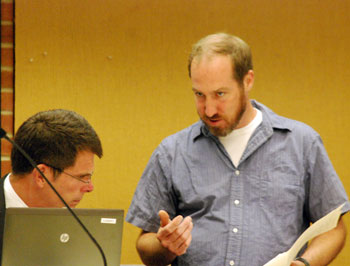
Jeff Hayner (standing) talked with city administrator Steve Powers (seated) before the meeting started.
The bike sharing program that the council was being asked to support was a “winner in many ways,” he contended. The cost to the taxpayers is relatively small, he said, compared to the grant money that it would leverage – citing the 20:80 ratio of local to federal support. The city’s non-motorized plan and the climate action plan both call for programs like the bike sharing system, he said, with goals of mitigating congestion, improving air quality, and encouraging alternative means of transportation. He described the program as providing 125 bikes in 14 locations.
Hayner allowed that the locations in the university campus area and downtown don’t really serve the outlying neighborhoods. But he argued that the University of Michigan is also bearing the lion’s share of the costs, the UM deserved to receive the most benefit. He calculated the city’s cost at about $300 per bike per year, and characterized that as fair in light of the societal benefits. He concluded by saying he hoped that if the bike sharing program were successful, it could be held out as an example of a new, cooperative spirit between the University of Michigan and the city of Ann Arbor.
Bike Share Program: Council Deliberations
Sally Petersen (Ward 2) led off by saying that she had mixed feelings about the plan. She said she’s disappointed that there’s not a communications plan for safety in the city’s parks – saying she’d like more signs on mixed-use paths. She didn’t feel like the city has the safety infrastructure and adequate bike lanes to support a bike share program. Her vote, she said, was “not yet.”
Responding to Petersen’s remarks about the adequacy of bicycling safety infrastructure, mayor John Hieftje said that the plan was never to put bike lanes on every downtown street, because the traffic moves slow enough in some places that bicycles can keep up with cars. Sabra Briere (Ward 1) agreed with Petersen about the need for more education. Briere said that signage is great, but she didn’t think that signage replaces “people paying attention.” Briere was encouraged that UM is a strong financial supporter. She noted that that bike share program is not about commuting, but rather about moving from places like State and Liberty to the corner of Huron and Main (the Washtenaw County building).
Stephen Kunselman (Ward 3) recalled the bike share program that Jeff Hayner had described during public commentary. The bicycles were painted green and were made available, and they disappeared to the far reaches of the city, never to return to the downtown, Kunselman said. He described the number of abandoned bikes downtown and on the campus that clutter the streets. He ventured that the bike share program might help to “clean up our streets.”
Kunselman talked about the “carrying capacity” of the environment. He was concerned about the fact that the money is coming from the alternative transportation fund, and might be taking away from other needs. Transportation program manager Eli Cooper described the intended use of the fund as making improvements as well as maintaining non-motorized infrastructure. Kunselman asked for examples of maintenance activities. Cooper explained that if anything were to be deferred, then it would be a half-mile of bike lane, including signs. That project would be postponed for about a year, he said.
Kunselman clarified that this is “seed money.” That’s right, Cooper replied, saying that it’s for capital needs. The University of Michigan is contributing operating money and the CEC is working on sponsorship revenue and handling fare revenue, Cooper explained. Cooper sketched a vision of public/private cooperation.
Kunselman asked about the clutter on downtown sidewalks. He wanted to know if the specific locations for bike share stations will require council approval. Cooper indicated that the right-of-way permitting program is authorized by the council, but the individual locations wouldn’t need approval.
Cooper responded to Petersen’s concern about adequate signs in the park system, by indicating it’s on the work plan. Jane Lumm (Ward 2) reported she’d heard about mishaps in the parks – pedestrians being “slammed into” by bicyclists. She felts that bicyclists are now more inclined to commute by bicycle on paths in the parks. She brought up the issue of bells. Craig Hupy, the city’s public services area administrator, told Lumm he has a bell on his bike and he’s one of those people who commutes through parks.
Lumm observed that obviously a lot of effort has gone into the bike share initiative. She appreciated the responses she’d received to questions about its impact on the alternative transportation program. She said the bike share program is appropriate to Ann Arbor. But she also expressed skepticism, saying that the city doesn’t prioritize its transportation programs. She objected to the fact that there’s not a long-term plan for the operating expenses – saying that UM’s commitment ends after three years. Still, she said she’d support the resolution.
Chuck Warpehoski (Ward 5) asked Cooper about the CMAQ grant deadline. Cooper indicated that there’s a deadline at the end of the federal fiscal year – Sept. 30.
Briere ventured that the council will hear that some of the bicycle lanes are in bad shape and that the city should spend the money on maintenance of bike lanes and not a bike share program. What’s being done to maintain bike lanes? Cooper replied to Briere by explaining he conducts an annual visual inspection of the entire bike lane system. An inventory of the bike lane inspections is available online, he said – saying it’s part of the city’s Bicycling in A2 website. He described the citizens request system for repairing potholes.
Petersen asked how long it would take before signs will show up in the parks. City administrator Steve Powers indicated he can provide an answer the following day. Petersen asked how to obtain a specific piece of educational literature about what every motorist should know about bike lanes. Cooper listed off various locations where it’s available and ways it’s distributed.
Marcia Higgins (Ward 4) said she doesn’t think the city has done a good job of educating cyclists. She described bicyclists who go through red lights. But she also described encountering a cyclist who was using proper hand signals and discovered that it was her council colleague, Chuck Warpehoski. She oftentimes sees cyclists go up on the sidewalk and use the crosswalk, she said. Higgins expressed concern that the city would be suddenly adding a lot of additional cyclists. About the city’s readiness for a bike share system, “I don’t think we’re there, yet,” Higgins said. Cooper ventured that the bike share program is another point of contact for additional educational efforts.
Higgins responded to Cooper by saying that handing someone a pamphlet doesn’t educate them about what they need to do. She thought users of the bike share system should have to pass a test. Petersen indicated she’s not concerned about educating cyclists, because they know their risks. Instead, Petersen said she’s concerned about the education of motorists.
Mike Anglin (Ward 5) stated that he thinks it’s a good program. Matt Sandstrom from the CEC fielded some questions. Anglin asked if helmets are required to use the bike share system. That’s a tricky question, Sandstrom replied. He pointed out that helmets are not required by law in Michigan. Education about helmets could be placed on the bike station kiosks, he suggested. CEC would be pro-helmet, Sandstrom said.
Anglin asked if most of the users are anticipated to be younger. Not necessarily, Sandstrom replied.
Kunselman picked up the idea of education, saying that education needs to be taking place in schools. He asked if anyone remembered the rule about bicycles needing to give an audible signal before overtaking a pedestrian. He also pointed out that pedestrians don’t follow the rules of the road, either. This isn’t about education, but rather about bike sharing, Kunselman said. It’ll be the first in the state, he said.
Outcome: The council voted to approve the $150,000 allocation over two years to support the bike sharing program. Dissenting were Sally Petersen (Ward 2) and Marcia Higgins (Ward 4).
Repeal of “Stand Your Ground”
A resolution added to the agenda on Tuesday before the Thursday meeting called upon the state legislature to repeal Michigan’s version of a “stand your ground” law, as well as to repeal legislation that prevents local municipalities from regulating the sale, transfer, transportation, or possession of firearms and ammunition. [.pdf of Self Defense Act 309 of 2006] [Firearms and Ammunition Act 319 of 1990]
The resolution cited an “outpouring of local voices calling for the repeal of Michigan’s Stand Your Ground Law,” that were heard following the mid-July verdict in the Trayvon Martin case. That included public commentary at the council’s July 15, 2013 meeting as well as subsequent public demonstrations.
The Trayvon Martin case involved an African American youth, Martin, who was shot and killed by George Zimmerman. Zimmerman was found not guilty of the crime, based on Florida’s “stand your ground” law.
Repeal of “Stand Your Ground”: Public Commentary
Lefiest Galimore led off public commentary at the start of the meeting with remarks on the topic of the resolution about the “stand your ground” legislation. He offered his greeting so the mayor, the council, and other Ann Arbor citizens. He mentioned that he’d addressed the council at its previous meeting on this issue, as something they should take seriously. He noted that the meeting had just begun with a recitation of the Pledge of Allegiance, which includes the phrase, “And justice for all.” Galimore contended that “stand your ground” laws allow individuals to interpret for themselves what justice means. As a citizen in the community, Galimore said, he felt he deserved the council’s support. He said he could be subjected to someone’s interpretation of what the “stand your ground” law means. He felt that if the council would support the resolution, it could be added to the support of other local units of government and be presented to state legislators. He urged councilmembers to support the resolution. Galimore’s remarks generated applause from the roughly two dozen people standing in support of his comments.
Blaine Coleman characterized “stand your ground” laws as licenses to hunt black men and black boys. It’s a sad thing, he said, that in 2013 black people have to come to a city council and ask: “Please don’t shoot us.” That’s an elementary demand that should have been fulfilled several hundred years ago, he said. Speaking only for himself, he said, he felt that the city council should go further, by passing a resolution urging $1 trillion to be spent on Detroit and every inner city. It’s easy for the U.S. Congress to cut a check for $1 trillion for a war in Iraq or Afghanistan, he said. And it’s easy to cut a check to bail out “Wall Street gamblers.” It should be equally easy to cut a check to rebuild Detroit and every inner city. It’s an elementary thing that should not require hand-wringing or complex decision making. Detroit was robbed over a period of a half century, he said, along with other inner cities. So they need to be rebuilt, Coleman concluded.
Mozhgan Savabieasfahani offered her perspective on racism in America – as someone from the Middle East, who had watched that area of the world be “plundered” with U.S. invasion and occupation. She characterized Trayvon Martin’s death as a lynching on the streets of America. The laws of this country don’t protect people of color, she said. That tells everyone in the world that racism is alive and well in the United States, and that racists will not see justice, she said. She described a protest during the Ann Arbor art fairs by some African American University of Michigan students. They had chanted, “Racism killed Trayvon,” and people of color had responded with cheers, but many white observers responded, “No, it didn’t.” She said that we’d do well do look inside ourselves and see how our laws promote racism, and then to change those laws.
Lucia Heinold also spoke in favor of the resolution on repealing “stand your ground” in Michigan. She introduced herself as a voter in Ward 5, so she thanked Chuck Warpehoski and Mike Anglin for sponsoring the resolution. She was impressed by the hard work that went into writing the resolution. It’s so easy to possess a gun that when you stand your ground, it’s quite possible that the person standing their ground will have a gun, she said. She said that Michigan’s law threw out centuries of common law that held that if people could not agree, then they should retreat. Heinold also contended that the evidence is that these types of laws are enforced in a disparate way, with people of color convicted disproportionately. She called Michigan’s “stand your ground” law the latest version of Jim Crow laws.
Repeal of “Stand Your Ground”: Council Deliberations
Sumi Kailasapathy (Ward 1) led off deliberations by thanking Chuck Warpehoski (Ward 5) for his hard work getting the resolution ready. She referred to the public commentary at the previous council meeting. She said she was aware that the council would face criticism for bringing a national issue to the city council agenda. So she wanted to make sure residents understood why the resolution is relevant. Part of her remarks included the statement that we don’t live in a post-racial society. There are groups that are still profiled, stalked and killed because they belong to a stigmatized minority group, she said. The 911 call transcripts, she said, clearly showed that the police did not want George Zimmerman to follow Trayvon Martin. But people like Zimmerman felt that the “stand your ground” law empowers them to take the law into their own hands, she noted.
A so-called self-defense law, Kailasapathy continued, turns into a “license to kill” in the hands of vigilantes. The reason the Trayvon Martin case had drawn national attention, Kailasapathy said, is that it showed the consequence of racial profiling and stereotyping and the inability of the courts to provide justice. Michigan’s version of the “stand your ground” law is flawed in a similar way to Florida’s law, she said – in that it condones the use of deadly violence, even when there’s an opportunity to retreat. By nullifying the common law duty to retreat, she said, it effectively removes any reasonable constraint on self-defense. Kailasapathy concluded: “Historically, African Americans have been oppressed – economically, culturally, socially, legally. We need to put a stop to this history of oppression now, and we as a city council should pass this resolution.”
Sabra Briere (Ward 1) thanked Kailasapathy and Warpehoski for the work they’d done to produce the language of the resolution. She described herself as someone who’s “not big on guns.” The idea that guns could be used in the way that Michigan’s “stand your ground” law allows had not occurred to her and was “news to her.” She said that someone who’s in fear for their life has a right to defend themselves, but someone who simply feels intimidated in a public place still has the ability to walk away. And that ability to walk away is something that should be encouraged, Briere said.
Warpehoski thanked Kailasapathy and Briere. The more he’d looked into “stand your ground” laws, the more disturbed he’d become, he said. Such laws do not reduce property crime rates, but rather increase murder rates, he said. The application of the laws has a disparate impact. He characterized the burden on prosecutors in connection with such laws as unreasonably high. He hoped the resolution would be heard by legislators in Lansing as more than just an editorial comment.
Mayor John Hieftje thanked the sponsors of the resolution for their work. He allowed that it might not sway a lot of people in the state capitol. He supported especially the second resolved clause on gun laws.
Marcia Higgins (Ward 4) told her colleagues that she’d be consistent as she has been for 14 years in opposing this kind of resolution. She contended that it’s a much more powerful message for individuals to send the message, instead of the city council. The legislature isn’t really listening to the Ann Arbor city council, she said. So individuals would have the potential to have a stronger impact. While she shared the sentiments in the resolution, she did not know that everyone in the city feels the same way about the resolution.
Stephen Kunselman (Ward 3) would support the resolution, but cautioned that there’s a lot more going on in the world than we realize. He’d visited the Washtenaw County clerk’s office a few times in the last few months, he said, [submitting campaign finance reports, for example] and remarked on the lines of people coming in to get concealed weapons permits, saying it was “breathtaking.”
Continuing on that theme, Kunselman said: “It’s disturbing. It makes me wonder: Why don’t we all just get them? … I’m sure we all know somebody who has a concealed weapons permit. I think we should be talking to them: Why do they have them? I know that I’ve thought about getting one, just for sitting here, because of the concerns that I have – but I haven’t.” Some kidding from other councilmembers ensued, as they told him that now he would need one. He responded by saying, “I’ll walk away.”
Sally Petersen (Ward 2) acknowledged Higgins’ point of view, but said the resolved clause about gun laws moved her. She called it a public safety issue, and noted that public safety was a priority that the council had adopted as a budget priority. Margie Teall (Ward 4) said she appreciated everyone’s work on the resolution and said it’s the kind of issue that had prompted her to get involved in politics 13 years ago. She expressed some skepticism, however, that it would have any effect.
Jane Lumm (Ward 2) appreciated Higgins’ point of view. She said the council needs to be cautious about venturing down this path – sending messages on issues that the council was not elected to address. However, she felt differently about this one. She agreed with Petersen that the resolution speaks to the issue of public safety. She said that local control over firearms is a good thing. So she was comfortable sending this message to the state legislature.
Outcome: The council voted to pass the resolution calling on the repeal of Michigan’s “stand your ground” law, with dissent from Marcia Higgins (Ward 4).
Kerrytown Place: Rezoning, Site Plans
The council was asked to give final approval for two rezoning requests in connection with Kerrytown Place development. The council had given initial approval to the requests at its July 1, 2013 meeting. The two parts of the project – one fronting Main Street and the other Fourth Avenue – were treated separately for the purposes of the rezoning request. In both cases, the requested rezoning is from PUD (planned unit development district) to D2 (downtown interface base district).
The 18-unit townhouse project that developer Tom Fitzsimmons is planning to build is much smaller than The Gallery, for which the PUD zoning had originally been approved at the request of a different owner. The city planning commission gave Kerrytown Place a unanimous recommendation of approval at its May 21, 2013 meeting. On the North Main Street side, the project would include a 16-unit townhouse building with an underground parking garage, 12 carport parking spaces and 24 surface parking spaces. On the North Fourth site – now a surface parking lot – the plan calls for constructing a duplex with a 2-car garage for each unit and a 21-space parking lot. Each unit of the duplex would face North Fourth Avenue.
The corresponding site plans for each part of the project had corresponding agenda items. As part of the development agreement, the project must achieve the disconnection of five footing drains from the sanitary sewer system elsewhere in the city. The city has temporarily suspended part of footing drain disconnection program, but the developer mitigation offset portion of that program remains in place.
No one spoke at any of the four public hearings related to this project.
Kerrytown Place: Council Deliberations
The agenda was altered to group the rezoning items with their corresponding site plan approvals. Deliberations were scant. Sabra Briere (Ward 1) called the development an appropriate scale for the neighborhood.
She encouraged support for the “downzoning.” Stephen Kunselman (Ward 3) asked planning manager Wendy Rampson how much it’s costing the petitioner to go through the process of rezoning.
The background to Kunselman’s question was that he’d put forward a resolution for a council-initiated rezoning of the parcel, which was voted down by other councilmembers a year earlier on Aug. 20, 2012. At that time, the parcel was in the hands of the Washtenaw County treasurer, as a result of a foreclosure proceeding.
Rampson responded to Kunselman’s question by venturing that it might be costing developer Tom Fitzsimmons around $20,000.
About the site plans, Briere characterized it as an opportunity for the council to approve a site plan that’s completely supported by the people who live in the area.
Outcome: The council voted unanimously to approve the rezoning for the Kerrytown Place project, as well as the site plans – on four separate votes.
Waldenwood Sidewalk Design Budget
The council was asked to approve a $10,000 design budget for a sidewalk to fill in a gap from the northeast corner of Penberton Ct. and Waldenwood northward to connect to the path leading the rest of the way to the King Elementary School.
In its form, the resolution was similar to other sidewalk design budgets the council has been asked to approve in recent months. [For example, the council has approved similar design budgets for a sidewalk on Barton Drive at its July 15, 2013, a sidewalk on Newport Road at its Jan. 22, 2013 meeting, and for a sidewalk on Scio Church Road at its Nov. 19, 2012 meeting.]
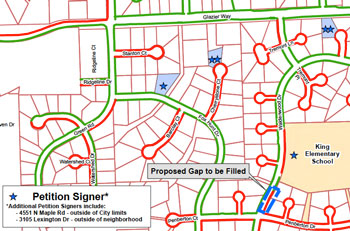
Waldenwood sidewalk gap. Green indicates existing sidewalks. Red indicates a sidewalk gap. Blue stars indicate signers of a petition in support of the sidewalk.
However, the sidewalk gap near King Elementary School includes a history of advocacy by nearby resident and former Ann Arbor Public Schools board member Kathy Griswold dating back to 2009.
For students crossing Waldenwood from the west to attend school, the segment of sidewalk would allow them to make the crossing at the intersection, where there is a four-way stop – instead of crossing the street using a mid-block crosswalk. According to the staff memo accompanying the resolution, “The Ann Arbor Public Schools (AAPS) Transportation Safety Committee has agreed the use of a new crosswalk at this stop controlled location would be preferable over the existing mid-block crossing at the school entrance.”
From the fall of 2009 through the spring of 2010, Griswold addressed the council on at least nine occasions on the topic of the King school crosswalk and the related sidewalk gap. The construction of a sidewalk had been met with opposition by the immediately adjoining property owners. The funding of new sidewalks – as contrasted with repair of existing sidewalks – is typically achieved at least partly through a special assessment on adjoining property owners. Sidewalk repair – but not new construction – can be paid for with the city’s sidewalk repair millage.
Waldenwood Sidewalk: Council Deliberations
The proposed sidewalk location is in Ward 2. Sally Petersen (Ward 2) led off deliberations by saying she was happy to see this come to the council in a formal process, noting that it has been debated since 2009. Petersen stated that the AAPS safety committee minutes from that era don’t indicate clearly that the group endorsed moving the crosswalk from mid-block to the four-way stop. City traffic engineer Pat Cawley stepped to the podium to offer his recollection of the meeting.
Sumi Kailasapathy (Ward 1) asked public services area administrator Craig Hupy to the podium. She asked if the project would come to a halt if the property owners objected. Hupy indicated that if the council approves the resolution on its agenda, then the city staff would meet with the community and then come back for the second resolution in the special assessment process. Kailasapathy confirmed with Hupy that it’s a council decision, not one made by the adjoining property owners. Hupy indicated there are three chances to kill the project along the way in the special assessment process. Stephen Kunselman (Ward 3) got additional confirmation that the property owner can’t kill the project.
Jane Lumm (Ward 2) thanked staff for their work. She asked how residents would be notified for the next step. Hupy explained that they’d be mailed a meeting notice. He ventured that there could be more than one meeting. Lumm noted that it would have made sense to undertake the sidewalk construction when Waldenwood was recently repaved. She indicated that she was glad that this is going through a formal process.
Sabra Briere (Ward 1) asked for the approximate timeline for the project. Hupy couldn’t speak to exact details, but characterized it as a relatively simple project from an engineering and design perspective. The time-consuming part for this project would be the public engagement portion of the project, Hupy said. He thought it might come back to the council by late winter or spring of 2014.
Briere ventured that the sidewalk could be constructed by the start of school in the fall of 2014. Hupy allowed that might be possible.
Petersen said she thought the property owners wouldn’t be special-assessed because it’s on their rear lot lines. Hupy indicated that Petersen had picked up on the fact that there’s likely not anything that will be special-assessable in the project.
Outcome: The council voted unanimously to approve the design budget for the Waldenwood sidewalk.
Greenbelt
Two items appeared on the council’s agenda in connection with the city’s greenbelt: acceptance of a federal grant, and the appointment of a new member to the greenbelt advisory commission.
Greenbelt: $202,370 from FRPP
At its Feb. 19, 2013 meeting, the council had approved an application to the Federal Farm and Ranch Land Protection Program (FRPP) for the purchase of development rights on two properties in Lodi Township – the 78-acre Donald Drake Farm on Waters Road in Lodi Township, and for a 90-acre property owned by Carol Schumacher on Pleasant Lake Road in Lodi Township.
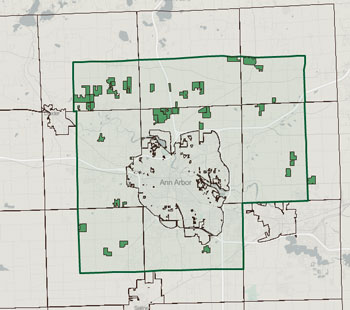
Properties currently protected through the Ann Arbor greenbelt program (smaller green areas) in the context of the greenbelt boundary (larger squarish region). (Data from the city of Ann Arbor mapped by The Chronicle on Aug. 3, 2013 with geocommons.com)
The city of Ann Arbor was notified recently that for the two properties, a total of $202,370 in matching dollars had been approved to fund the purchase of development rights – $50,960 for the Drake property and $151,410 for the Schumacher land. The council was asked to authorize the receipt of the federal matching funds.
The award of FRPP money comes in the context of the city’s greenbelt program, supported by a 0.5 mill tax approved by voters to acquire development rights on land to preserve open space.
Lodi Township covers the southwest corner of the greenbelt boundary area.
Jane Lumm (Ward 2) got confirmation that the issue would come back before the council for approval of the actual purchase of development rights, when all the funding sources are identified. Colin Smith, the city’s parks and recreation manager, responded to Lumm’s questions by saying that in the past, Lodi Township has contributed to the acquisition of development rights. Smith was filling in for community services area administrator Sumedh Bahl. Lumm said she looked forward to possible participation from Lodi.
Outcome: The council voted unanimously to authorize the receipt of the federal farmland protection money.
Greenbelt: Appointment to GAC
The appointment of John Ramsburgh to the greenbelt advisory commission had been postponed from the council’s July 15 meeting, which is customary for appointments to GAC. It’s one of the few boards or commissions whose members are nominated by the city council, not the mayor. The usual two-step process associated with appointments – nomination at one council meeting followed by confirmation at the subsequent meeting – is mirrored for GAC appointments by postponing action on a resolution appointing a representative until the following meeting.
Ramsburgh is a development officer with the University of Michigan’s College of Literature, Science & the Arts. He also is the son of Ellen Ramsburgh, a long-time member of the Ann Arbor historic district commission, and its former chair. He is filling a position previously held by Dan Ezekiel, who was term limited.
Outcome: The council voted unanimously, without discussion, to appoint John Ramsburgh to GAC. Appointments to GAC are for three years.
Public Art Administrator Contract
The council was asked to appropriate funds to pay for public art administrator Aaron Seagraves’ contract through the end of 2013. The amendment brings his total compensation for the period from June 11, 2011 through Dec. 31, 2013 to $48,900. The specific projects mentioned in the resolution, which require administrative work, are artwork in the Kingsley rain garden, Argo Cascades, and the East Stadium Blvd. bridges.

From left: Sumi Kailasapathy (Ward 1), Sabra Briere (Ward 1), Sally Petersen (Ward 2), and Jane Lumm (Ward 2).
Sabra Briere (Ward 1) led off deliberations by saying she could imagine people asking why the city has a public art administrator, if the city doesn’t have a Percent for Art program any longer. She explained the need for a public art administrator by pointing out there’s old and new business to address. There’s the old business of artwork at the Kingsley rain garden, Argo Cascades, and East Stadium bridges. There’s also a need to address the new business of integrating the new public art program – which is not based on a 1% allocation from every capital improvement project – into the capital improvements program.
Public services area administrator Craig Hupy, who supervises Seagraves, explained to Briere that the reason that the contract extension goes through the end of the year is to allow for a bridge between the old Percent for Art program and the new program.
Sumi Kailasapathy (Ward 1) noted that an issue had come up when she and Jane Lumm (Ward 2) had attempted an amendment to the new public art ordinance that would have allowed money set aside for public art in previous years to be returned to its funds of origin. Kailasapathy said she really had a problem with the resolution, so she wouldn’t support it.
Lumm also said she had a problem with the resolution. She said she’d tried at every point to discontinue the Percent for Art program. Instead of returning the $800,000 in unspent funds, the council had decided to maintain a public art “slush fund,” she contended. She didn’t think that the council should continue to “throw good money after bad.” She would not support the continued spending on Percent for Art projects.
Marcia Higgins (Ward 4) asked why $18,500 was being appropriated for the public art administrator’s compensation, but $20,500 is the amount in the resolution. Hupy described miscellaneous supplies as accounting for the $2,000. Hupy pointed out that the information was provided in answers to the council’s caucus questions.
Sally Petersen (Ward 2) indicated she’d support the resolution – because she wants the area around the Dreiseitl sculpture outside city hall to become ADA compliant. Kailasapathy asked why a public art administrator would be handling ADA compliance. City administrator Steve Powers responded by saying that hasn’t been decided yet.
Mike Anglin (Ward 5) calculated that the public art administrator is being paid only $20/hour. He called that a bargain. Stephen Kunselman (Ward 3) indicated he’d support the allocation, because it’s a small amount. But he cautioned that he might not vote to support spending the money on the remaining Percent for Art projects in the pipeline. He said the pressure is on the public art commission to bring forward a high quality piece of art. Kunselman could say right then that he’s not going to vote to spend money on “anything that’s hanging from a light pole.” That was a reference to the recommended project for the East Stadium bridges location, proposed by artist Catherine Widgery and recommended by a task force.
Briere asked what would happen if the council voted not to spend the money on the East Stadium bridges location. Would the money revert to the public art fund? Powers responded to Briere’s question by saying that’s for the council to decide. The council could say to the public art commission, “Try again,” Powers said. Briere pointed out that the council would still need to amend the city’s public art ordinance in order to return public art funds to their funds of origin.
Mayor John Hieftje supported the resolution, saying that it’s necessary to have administrative support for the art program. Margie Teall (Ward 4) reiterated that point – that a successful art program requires an administrator. Teall said that residents do see the value of public art, and having an administrator is vital.
Christopher Taylor (Ward 3) stated that there was a common understanding, if not a unanimous one, that a transition from the old program to the new program would need to be funded. He called for honoring the effort that had gone into this.
Outcome: The council voted to approve the contract extension for the public art administrator, Aaron Seagraves, over dissent from Jane Lumm (Ward 2) and Sumi Kailasapathy (Ward 1).
Appointments, Nominations
Pending a possible council rule change that would slot mayoral appointments and nominations to boards and commissions earlier in the meeting, those items still come near the end of the meeting. The council will vote on the rule change at its Sept. 3, 2013 meeting.
Appointments
The council was asked to confirm mayoral nominations made at the previous council meeting on July 15: Sue Perry to the Elizabeth Dean Fund committee; and Evan Nichols to the zoning board of appeals.
Outcome: The council voted to confirm Perry and Nichols.
Nominations
Highlights from nominations for boards and commissions added on Aug. 6 include Rishi Narayan to replace Leah Gunn on the board of the Ann Arbor Downtown Development Authority. Narayan is founder and managing member of Underground Printing, which offers screenprinting of apparel in more than a dozen cities nationwide. Narayan made the Crain’s Detroit Business “Twenty in their 20s” list in 2010 as a 28-year-old.
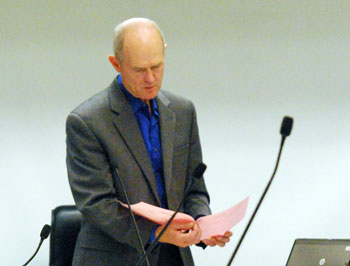
Mayor John Hieftje before the start of the Aug. 8 meeting. Nominations are printed out on pink sheets for councilmembers.
Jack Bernard is being nominated to the board of the Ann Arbor Area Transportation Authority. When the AAATA articles of incorporation were changed recently to add the city of Ypsilanti as a member, the board was expanded from seven to nine members. One of the two additional seats is appointed by the city of Ypsilanti. Gillian Ream was appointed to that spot. Bernard’s appointment would fill the additional slot appointed by the city of Ann Arbor.
Bernard is a lecturer in the University of Michigan law school and an attorney with UM’s office of the vice president and general counsel. He is also currently chair of the university’s council for disability concerns. Given the nature of wrangling over Eric Mahler’s recent appointment to the AAATA board, Bernard’s chairship of that group could be a key qualification. Some councilmembers objected to Mahler’s appointment, arguing that someone who could represent the disability community should be appointed instead.
Mayor John Hieftje did not offer explanations for any of the nominations he put forward at the Aug. 8 meeting.
Originally slated on the agenda to replace Newcombe Clark on the board of the Ann Arbor DDA was Al McWilliams. However, the final version of the agenda did not include his name. Al McWilliams is founder of Quack!Media, an ad agency located in downtown Ann Arbor. Quack!Media lists the Ann Arbor Transportation Authority on its website as one of its clients. McWilliams has written advocacy pieces for bicycling on his blog.
Originally slated for nomination to serve on the public art commission was Jeff Hayner. But the final version of the nomination list did not include his name. He has filed petitions to run for the Ward 1 city council seat. The Ward 1 city council ballot for November will include incumbent Democrat Sabra Briere, and independents Hayner and Jaclyn Vresics.
The nominations put forward on Aug. 8 will be put before the council for a confirmation vote on Aug. 19.
Communications and Comment
Every city council agenda contains multiple slots for city councilmembers and the city administrator to give updates or make announcements about important issues that are coming before the city council. And every meeting typically includes public commentary on subjects not necessarily on the agenda.
Comm/Comm: Video Privacy, Surveillance
During public commentary reserved time at the start of the meeting, Meghan Clark introduced herself as a resident of Ward 1. She’s also a PhD student in computer science at the University of Michigan, she said. She addressed the video privacy ordinance, which the council had voted down at a recent meeting. She characterized the rejected law as requiring a democratic process to be followed before long-term video surveillance cameras could be installed. Technology is advancing faster than the law, she said. She held up a small device in her hand, explaining that it was a camera capable of high resolution, equivalent to HD video.
Clark also held up a Raspberry Pi, which is a computer capable of running advanced computer vision libraries. And the whole system could be powered with a cell phone charger. The components she had described, she continued, could be purchased online for about $60. A friend of hers in Washington D.C. runs a user group on drones, which has 471 active members. Police departments in 13 states have applied for, and in some cases received, FAA licenses to use drones for police work.
“Surveillance technology is here,” Clark said, but the legal predisposition to protect privacy is not. Privacy means having input into what happens to your personal information, Clark said. She was disappointed that the council rejected the video privacy ordinance. As a computer scientist and a citizen, she said, she was frightened. So she encouraged the council to pursue the suggestion that Stephen Kunselman (Ward 3) had made at the July 1 meeting, to at least develop policy guidelines for the future.
Comm/Comm: North Main Huron River Task Force
Sabra Briere (Ward 1) reported on the North Main Huron River task force. The due date of July 31 for a final report hadn’t been met, she said. She conveyed an apology from the task force. She expected the report will be completed by the end of August.
Comm/Comm: Planning Commission Update
Sabra Briere (Ward 1), who represents the city council on the planning commission, announced a meeting of the planning commission’s ordinance revisions committee (ORC) the following Tuesday, Aug. 13. A planning commission work session to start at 7 p.m. would be followed by an ORC meeting – to discuss the review of D1 (downtown core) zoning – at 8 p.m. The ORC meeting would run concurrently with a planning commission committee meeting on the non-motorized plan revision.
Comm/Comm: Disabilities Survey
Sally Petersen (Ward 2) called attention to a survey on disabilities being conducted by the United Nations Office for Disaster Risk Reduction (UNISDR).
Comm/Comm: Housing Commission Update
Margie Teall (Ward 4), who serves as liaison from the council to the Ann Arbor Housing Commission, gave an update on the AAHC. The weatherization at Hikone is done, she reported, and the window replacements for tenants are done at Baker Commons. A non-smoking policy will be implemented at all the housing commission properties, she said.
Comm/Comm: Argo Cascades
City administrator Steve Powers reported that usage at Argo Cascades is up over 50% for July compared to July last year.
Present: Jane Lumm, Mike Anglin, Margie Teall, Sabra Briere, Sumi Kailasapathy, Sally Petersen, Stephen Kunselman, Marcia Higgins, John Hieftje, Christopher Taylor, Chuck Warpehoski.
Next council meeting: Monday, Aug. 19, 2013 at 7 p.m. in the second-floor council chambers at city hall, 301 E. Huron. [Check Chronicle event listings to confirm date.]
The Chronicle could not survive without regular voluntary subscriptions to support our coverage of public bodies like the Ann Arbor city council. We sit on the hard bench so that you don’t have to. Click this link for details: Subscribe to The Chronicle. And if you’re already supporting us, please encourage your friends, neighbors and colleagues to help support The Chronicle, too!




